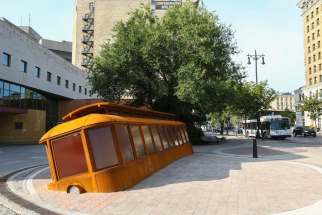Streetcar named disaster Public statue immortalizes infamous Bloody Saturday events
Read this article for free:
or
Already have an account? Log in here »
To continue reading, please subscribe:
Monthly Digital Subscription
$0 for the first 4 weeks*
- Enjoy unlimited reading on winnipegfreepress.com
- Read the E-Edition, our digital replica newspaper
- Access News Break, our award-winning app
- Play interactive puzzles
*No charge for 4 weeks then price increases to the regular rate of $19.00 plus GST every four weeks. Offer available to new and qualified returning subscribers only. Cancel any time.
Monthly Digital Subscription
$4.75/week*
- Enjoy unlimited reading on winnipegfreepress.com
- Read the E-Edition, our digital replica newspaper
- Access News Break, our award-winning app
- Play interactive puzzles
*Billed as $19 plus GST every four weeks. Cancel any time.
To continue reading, please subscribe:
Add Free Press access to your Brandon Sun subscription for only an additional
$1 for the first 4 weeks*
*Your next subscription payment will increase by $1.00 and you will be charged $16.99 plus GST for four weeks. After four weeks, your payment will increase to $23.99 plus GST every four weeks.
Read unlimited articles for free today:
or
Already have an account? Log in here »
Hey there, time traveller!
This article was published 16/08/2019 (2307 days ago), so information in it may no longer be current.
Every city is a stage, and every stage has a story.
For Noam Gonick, the Winnipeg General Strike of 1919 is one of the city’s greatest dramatic moments. “It’s the big drama that happened here,” says the local director. “There’s something very theatrical about Bloody Saturday.”
The strike was the largest and longest in Canadian history. Between May 15 and June 29, 1919, more than 30,000 workers walked off the job, demanding better wages and working conditions.

On Saturday, June 21, of that year, crowds gathered on Main Street to peacefully protest the arrest of 10 leaders of the Central Strike Committee, which had occurred several days earlier.
When a streetcar attempted to travel through the protest — south on Main Street towards Portage Avenue — the protesters stopped it, tipped it over and set it on fire. The North West Mounted Police and special constables hired by the city moved in to quell the protest; there were numerous injuries and two people were killed.
The date, now known as Bloody Saturday, has been immortalized in a new sculpture of the same name by Gonick and Toronto-born sculptor Bernie Miller.
Set in the plaza in front of Pantages Playhouse Theatre, at the corner of Main Street and Market Avenue, it’s a replica streetcar — almost 10 metres long, 2.4 metres wide, and 3.7 metres tall — made of weathering steel, stainless steel and glass (weathering steel reacts with the elements to create a orange, rust-like patina). Lit from within and with a working headlamp, it’s sunk in the concrete at a permanent angle that echoes photographer L.B. Foote’s famous black-and-white image of the tilted car.
Gonick is no stranger to the subject matter — one of his earliest films, 1919, took a revisionist look at the Winnipeg General Strike — but his return to the material was unexpected.
“I was just as surprised as anyone that I was still doing stuff on the general strike,” he says. “I never intended coming back to it, but sometimes artists can’t just get certain topics out of their oeuvre.”
Though Gonick is best known for his work in film and installation, his passion for the arts began with theatre. “Me and a bunch of my friends created a theatre company. We were the first group to use the Gas Station Theatre when it opened in the 1980s,” he recalls. His interest in theatre has continued to this day — he works as a director for companies such as Tara Players.
Every artist has a process, and Gonick’s well-crafted sense of the theatrical drew him back to this defining moment of Winnipeg’s history. “You can’t really refuse the muse when it comes to you. It came to me like a streetcar going down the tracks and I just had to pay attention.”
The sculpture has been installed in a similarly dramatic location: across from city hall, and right in the heart of Winnipeg’s theatre district.
“It’s the most intense thing that we have ever produced here,” says Gonick of the work, which was built by DMS Industrial Constructors in Transcona, “and it’s wonderful to have the statue where it is, where audiences going to concerts, shows and festivals can see it.”

Gonick had the initial inspiration for Bloody Saturday, but he quickly found a collaborator.
“I immediately took the idea to Bernie Miller and he interpreted it as a public art sculpture,” Gonick says. “He did the drawing and oversaw the initial meetings with fabricators and engineers. He really figured out logistically how to make it happen.”
The Winnipeg Arts Council also played a vital role in the creation of the piece. “The sculpture would not have happened without the commission from the WAC,” adds Gonick. “They were on board as soon as they heard the idea.
“They supported the piece financially with a quarter of a million dollars and helped us raise the remaining funds. They were also integral in securing the location for the sculpture on the corner of Portage Avenue and Market Avenue.
“They were fantastic.”
With funding secured, Gonick and Miller got to work. Upon completion of the drawings, Miller said to Gonick, “Our work here is done.”
Not long after, on Oct. 22, 2017, Miller died at the age of 69.
Theatrical timing, indeed.
In life as in death, Bernie Miller was something of an enigma to many people. A prolific Canadian artist, it may be surprising to learn he only produced one solo exhibition of work; none of those sculptures or drawings was ever purchased.
“Bernie never expected his large sculptures to be sold,” says his longtime partner, the esteemed cultural critic, writer, performance artist and psychiatrist Jeanne Randolph. “He called them ‘stage sets,’ sometimes throwing them away.”

The impermanence and ephemerality of many of Miller’s pieces stands in confusing opposition to that of his final work, which is a permanent work of public art.
“Bernie eschewed the limelight and never agreed to giving artist talks,” says Randolph, in her generous reflection of Miller’s work and life. “He had no interest in autobiographic or expressionistic art.”
But she is quick to remind us that artists — just like the rest of us — grow and change. “It was only in the few years before he died that he realized how, in some hidden layer of his mind, his work had the undertones of autobiography.”
Bloody Saturday is permanently on display for the public, free and at any time of day or night at the Pantages Theatre Plaza.
frances.koncan@freepress.mb.ca
Twitter: @franceskoncan

Frances Koncan (she/her) is a writer, theatre director, and failed musician of mixed Anishinaabe and Slovene descent. Originally from Couchiching First Nation, she is now based in Treaty 1 Territory right here in Winnipeg, Manitoba.
Our newsroom depends on a growing audience of readers to power our journalism. If you are not a paid reader, please consider becoming a subscriber.
Our newsroom depends on its audience of readers to power our journalism. Thank you for your support.









